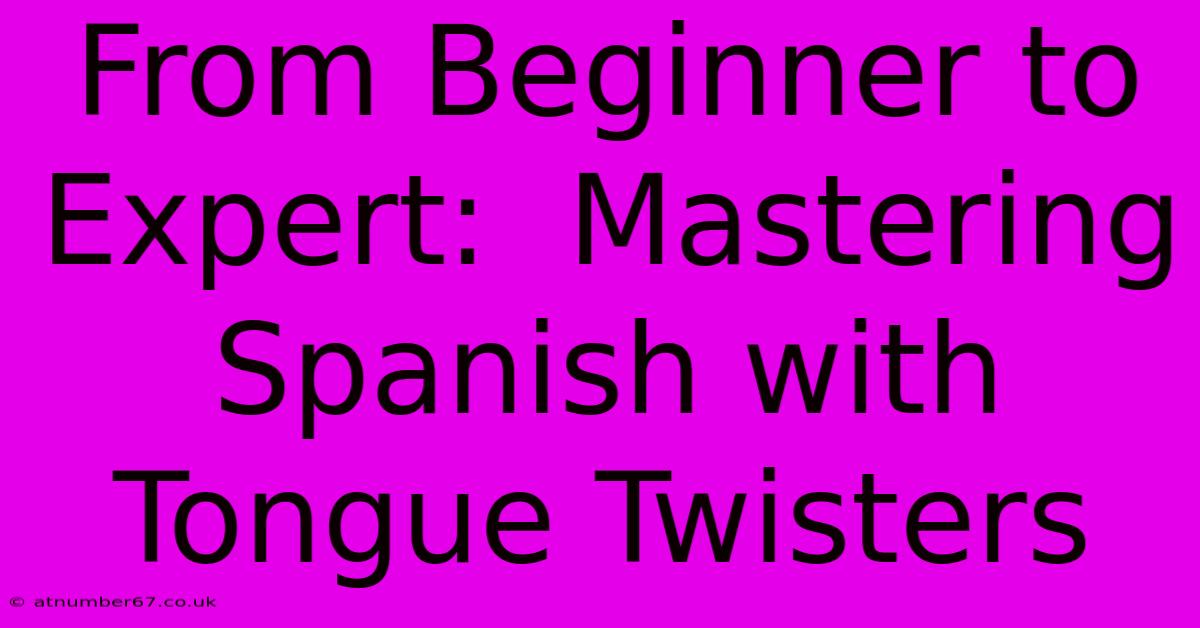From Beginner To Expert: Mastering Spanish With Tongue Twisters

Table of Contents
From Beginner to Expert: Mastering Spanish with Tongue Twisters
Learning a new language can be a challenging yet rewarding journey. While textbooks and classes provide a solid foundation, sometimes you need a fun and effective way to boost your pronunciation, fluency, and overall confidence. That's where Spanish tongue twisters come in! This comprehensive guide will show you how to leverage the power of trabalenguas (tongue twisters) to take your Spanish skills from beginner to expert.
Why Use Tongue Twisters to Learn Spanish?
Tongue twisters, or trabalenguas, are short phrases or sentences designed to be difficult to pronounce quickly. They're incredibly effective for several reasons:
-
Improved Pronunciation: Repeatedly practicing tongue twisters forces you to articulate sounds correctly, honing your pronunciation of tricky consonants and vowels. This is crucial for clear and understandable speech.
-
Enhanced Fluency: The rapid repetition involved in tongue twisters helps improve your speed and agility when speaking. You'll find yourself becoming more fluent and less hesitant.
-
Increased Confidence: Mastering a difficult tongue twister builds confidence. This increased self-assurance will translate to other aspects of your Spanish learning, making you more comfortable speaking the language.
-
Fun and Engaging Learning: Unlike rote memorization, tongue twisters offer a fun and engaging way to practice. This makes learning less tedious and more enjoyable, leading to better retention.
-
Develop Ear Training: By listening to native speakers pronounce these twisters, you enhance your ability to recognize and distinguish subtle sounds in the language.
Starting with the Basics: Easy Spanish Tongue Twisters for Beginners
Beginners should start with simple tongue twisters focusing on basic sounds and vocabulary. Here are a few examples:
-
"Pablito clavó un clavito. ¿Qué clavito clavó Pablito?" (Pablito hammered a little nail. What little nail did Pablito hammer?) This twister focuses on the "cl" sound.
-
"El perro de Pedro come poco pero es gordo." (Pedro's dog eats little but is fat.) This one works on the sounds "p" and "r".
-
"Tres tristes tigres tragan trigo en un trigal." (Three sad tigers eat wheat in a wheat field.) This focuses on the "tr" sound.
Practice Tip: Start slowly and focus on accurate pronunciation. Gradually increase your speed as you become more comfortable. Listen to audio recordings of native speakers to model your pronunciation.
Intermediate Challenges: Stepping Up Your Tongue Twister Game
Once you've mastered the basics, move on to more complex tongue twisters that incorporate more challenging sounds and sentence structures. For example:
-
"Me dijeron que diga algo, y yo les digo que no digo nada." (They told me to say something, and I tell them that I say nothing.) This twister works on the sounds "d" and "g" and challenges your ability to manage sentence complexity.
-
"El que compra y no paga, engaña a quien le haga la paga." (He who buys and doesn't pay, deceives whoever does the paying.) This is a longer twister that tests your rhythm and flow.
Practice Tip: Record yourself saying the tongue twister and compare it to a native speaker’s pronunciation. Identify areas where you need improvement and focus on those specific sounds.
Advanced Tongue Twisters: Reaching Fluency Mastery
For advanced learners, the goal is to master complex phrases with rapid-fire pronunciation and intricate sounds.
- "Si seiscientas seiscientas seiscientas seiscientas seiscientas y seis sillas quieren seiscientas seiscientas seiscientas seiscientas seiscientas y seis seiscientas." (If six hundred six hundred six hundred six hundred six hundred and six chairs want six hundred six hundred six hundred six hundred six hundred and six six hundred.) This is an extremely challenging twister, but conquering it will significantly boost your confidence and speed.
Practice Tip: Use a mirror to watch your mouth movements. This helps you identify any physical impediments to proper pronunciation. Engage in tongue twister competitions with other learners!
Beyond the Twisters: Integrating Tongue Twisters into Your Learning
Don't just treat tongue twisters as an isolated exercise. Integrate them into your broader Spanish learning strategy:
-
Combine with other learning methods: Use them alongside textbooks, language exchange partners, and immersion activities.
-
Make it a daily habit: Dedicate a few minutes each day to practicing tongue twisters.
-
Find tongue twister resources: Explore online resources and apps dedicated to Spanish tongue twisters.
-
Use them in conversation: Try incorporating the words and sounds from your favorite tongue twisters into everyday conversations.
Mastering Spanish with tongue twisters is a fun, effective, and engaging way to improve your pronunciation, fluency, and confidence. So, grab a trabalenguas, embrace the challenge, and watch your Spanish skills flourish!

Thank you for visiting our website wich cover about From Beginner To Expert: Mastering Spanish With Tongue Twisters. We hope the information provided has been useful to you. Feel free to contact us if you have any questions or need further assistance. See you next time and dont miss to bookmark.
Featured Posts
-
A Mothers Fight Secret Mom Vs Evil Brides Empire
Apr 01, 2025
-
The Untold Story Of Doug Fregins Financial Success
Apr 01, 2025
-
Daniel Ricciardo His Financial Success Story Unfolds
Apr 01, 2025
-
Mike Woodsons Daughter A Life Of Passion And Purpose
Apr 01, 2025
-
Sundar Pichais Net Worth Beyond The Numbers
Apr 01, 2025
